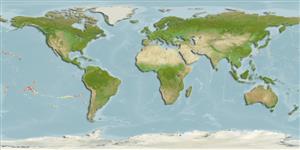Classification / Names
Noms communs | Synonymes | Catalog of Fishes(Genre, Espèce) | ITIS | CoL | WoRMS | Cloffa
>
Gadiformes (Cods) >
Macrouridae (Grenadiers or rattails)
Etymology: Pseudocetonurus: Greek, pseudes = false + Greek, ketos = marine monster, whale + Greek, oura = tail (Ref. 45335); septifer: From the strongly-developed and distinct septa in the postorbital seismosensory canal (Ref. 41160).
Environment: milieu / climate zone / depth range / distribution range
Écologie
marin benthopélagique; profondeur 340 - 950 m (Ref. 9949). Deep-water
Northwest Pacific: Taiwan (Ref. 54421). Eastern Pacific: Nazca and Sala y Gomez ridges and Hawaiian Islands.
Taille / Poids / Âge
Maturity: Lm ? range ? - ? cm
Max length : 39.0 cm TL mâle / non sexé; (Ref. 9949)
Description synthétique
Morphologie | Morphométrie
Seven branchiostegal rays. Head notably large and broad; preopercle and suborbital bones deep and large, opercle commensurately small; orbit small, 19%-30% HL, diameter much less than broad interorbital; snout high, slightly projecting beyond mouth. Mental barbel small, 10% or less of HL. Gill opening wide, extending forward to below hind end of maxilla; gill membranes loosely and narrowly attached to isthmus. Gill rakers usually 16-17 on inner series of 1st arch. Teeth small, close-set, in narrow tapered band on premaxilla, uniserial on dentary. Scales with numerous small, awl-shaped spinules; no reticulations on anterior field; lateral line scales absent, a series of dark papillae in their place. Vent about halfway between pelvic fin insertion and anal fin origin (usually closer to pelvic insertion), surrounded by a black, oval to teardrop-shaped naked area and preceded by a small, round dermal window of light organ between pelvic fin bases. Pyloric caeca short, 22-24. Color black to dark brown overall (Ref. 54421).
Life cycle and mating behavior
Maturité | Reproduction | Frai | Œufs | Fécondité | Larves
Sazonov, Y.I. and T. Iwamoto, 1992. Grenadiers (Pisces, Gadiformes) of the Nazca and Sala y Gomez ridges, southeastern Pacific. Proc. Calif. Acad. Sci. 48(2):27-95. (Ref. 9949)
Statut dans la liste rouge de l'IUCN (Ref. 130435)
Menace pour l'homme
Harmless
Utilisations par l'homme
Plus d'informations
Noms communsSynonymesMétabolismePrédateursÉcotoxicologieReproductionMaturitéFraiRassemblement de ponteFéconditéŒufsDéveloppement de l'œuf
Taille/ÂgeCroissanceLongueur-poidsLongueur-longueurFréquences de longueursMorphométrieMorphologieLarvesDynamique des populations larvairesRecrutementAbondanceBRUVS
RéférencesAquacultureProfil d'aquacultureSouchesGénétiqueElectrophoresesHéritabilitéPathologiesTraitementNutrientsMass conversion
CollaborateursImagesStamps, Coins Misc.SonsCiguateraVitesseType de nageSurface branchialeOtolithesCerveauxVision
Outils
Articles particuliers
Télécharger en XML
Sources Internet
Estimates based on models
Preferred temperature (Ref.
123201): 4.5 - 5.7, mean 5.1 °C (based on 18 cells).
Phylogenetic diversity index (Ref.
82804): PD
50 = 1.0000 [Uniqueness, from 0.5 = low to 2.0 = high].
Bayesian length-weight: a=0.00219 (0.00111 - 0.00431), b=3.20 (3.03 - 3.37), in cm total length, based on LWR estimates for this (Sub)family-body shape (Ref.
93245).
Niveau trophique (Ref.
69278): 3.5 ±0.5 se; based on size and trophs of closest relatives
Résilience (Ref.
120179): Faible, temps minimum de doublement de population : 4,5 à 14 années (Preliminary K or Fecundity.).
Fishing Vulnerability (Ref.
59153): Low to moderate vulnerability (29 of 100).
